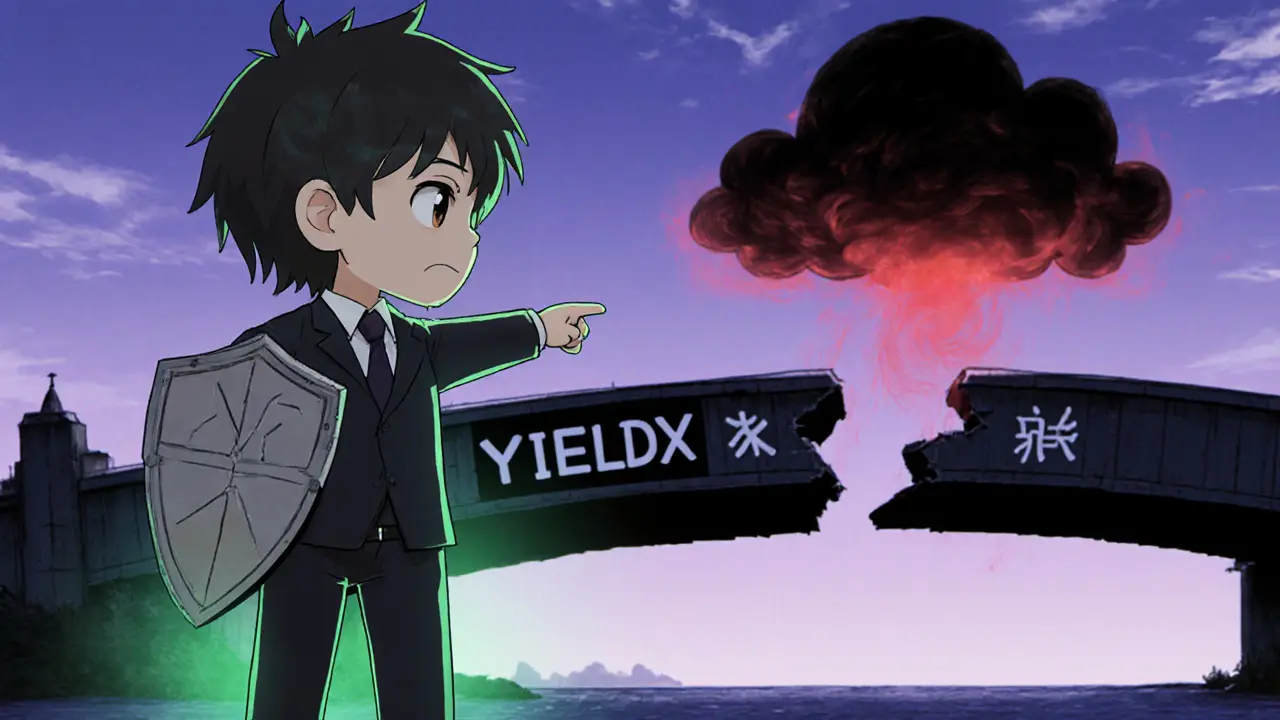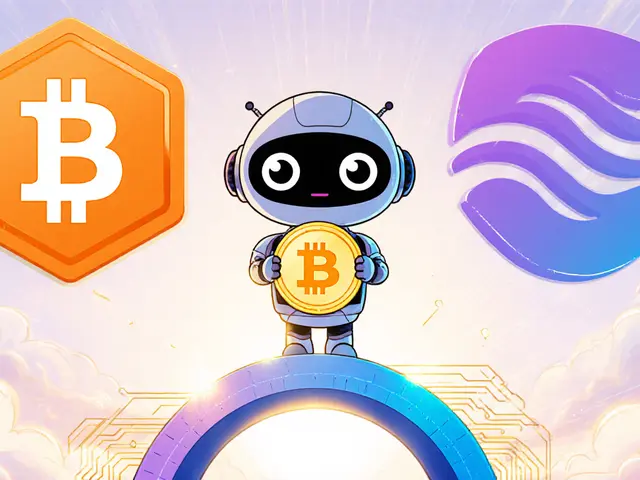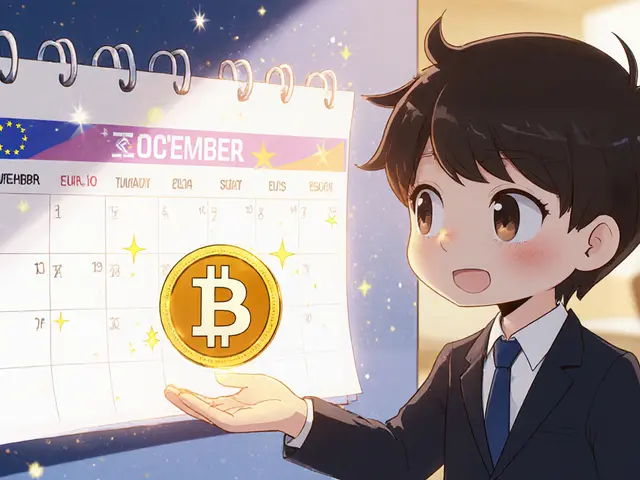YIELDX DeFi Token Risk Analyzer
Token Overview
This tool evaluates the Yield Finance (YIELDX) token based on key DeFi metrics to help determine its investment risk level.
Comparison with Established DeFi Tokens
When you see a new coin named Yield Finance (YIELDX), the first question is: what does it actually do? In short, Yield Finance claims to be a DeFi token that lets users farm yields, stake rewards and even dabble in GameFi, but the details are murky. Below we break down the token’s blockchain home, market data, technical quirks, and how it stacks up against proven DeFi giants like Uniswap or Aave. By the end you’ll know whether YIELDX is worth a glance or best left on the ignore list.
Quick Summary
- Yield Finance (YIELDX) is a micro‑cap DeFi token with uncertain blockchain (Ethereum‑or‑Pulsechain).
- Price hovers between $0.000105 and $0.00016, total supply ~29,200, zero circulating supply reported.
- Trading volume is effectively nil; liquidity pools are either hidden or non‑existent.
- No verifiable audits, community, or developer roadmap - high risk for investors.
- Compared to established DeFi tokens, YIELDX lacks TVL, governance, and active users.
Where Does Yield Finance Live? Blockchain Mystery
Official descriptions swing between two networks. One source says YIELDX lives on the Ethereum blockchain, positioning itself as a typical ERC‑20 yield‑farming token. Another major tracker lists it under “Yield Pulse,” tying it to Pulsechain, a newer Ethereum‑compatible chain that promises lower fees. This split creates three practical questions:
- Which chain actually hosts the smart contract?
- What consensus mechanism secures it (Proof‑of‑Work, Proof‑of‑Stake, or a hybrid)?
- Can users verify the contract address on a block explorer?
At the time of writing, a concrete contract address is hard to locate, and explorers on both Ethereum and Pulsechain return empty or “unverified” results. Without a verifiable contract, any claim about staking rewards or yield optimization remains speculative.
Tokenomics in Plain Sight
The token’s supply numbers are oddly precise: 29,200 YIELDX tokens total, with a reported circulating supply of zero. A fully diluted market cap of roughly $4.39 suggests the token is essentially dormant. Such a low supply can be a red flag because it often indicates that the project has either locked away most tokens for the team or simply never listed them on an exchange.
Typical DeFi tokens publish a clear breakdown - how many tokens go to the treasury, how many to liquidity mining, developer vesting schedules, etc. Yield Finance offers none of that. The absence of a transparent token‑allocation table makes it impossible to gauge inflation risk or the incentive structure that would attract liquidity providers.
Market Activity (or Lack Of It)
Price data is scattered across trackers, ranging from $0.000105 to $0.00016 per token. Daily volume is either listed as “N/A” or $0, meaning there are virtually no trades happening on the public markets. The token’s rank varies wildly - anywhere between #7,460 and #13,005 - which reflects the fragmented data rather than genuine market interest.
Low volume translates to high slippage. Even if you managed to buy a modest amount, exiting would likely require a massive price discount, exposing you to severe loss. For anyone who values liquidity, YIELDX fails the basic test.

How Does Yield Finance Compare to Established DeFi Tokens?
| Metric | Yield Finance (YIELDX) | Uniswap (UNI) | Aave (AAVE) | Compound (COMP) |
|---|---|---|---|---|
| Blockchain | Ethereum / Pulsechain (uncertain) | Ethereum | Ethereum | Ethereum |
| Total Supply | ~29,200 | 1000000000 | 16000000 | 10000000 |
| Circulating Supply | 0 (reported) | 600M | 12M | 7M |
| Market Cap (USD) | ~$4.39 | $12B | $3.5B | $2.1B |
| 24h Volume | $0‑$10K (unclear) | $1.2B | $600M | $420M |
| TVL (Total Value Locked) | None reported | $6B | $3B | $2.2B |
| Governance | No known forum | Active DAO | Active DAO | Active DAO |
| Audit Reports | None publicly available | Multiple audits | Multiple audits | Multiple audits |
The table makes it clear: YIELDX offers no liquidity, no TVL, and virtually no community governance. Established tokens deliver billions in value, active DAO voting, and audited smart contracts. For a newcomer, the risk‑reward ratio is heavily tilted toward risk.
Community, Documentation, and Development Transparency
Successful DeFi projects thrive on an open‑source ethos: public GitHub repos, regular dev calls, transparent roadmaps, and buzzing Discord or Telegram groups. A quick scan of Yield Finance’s online presence shows:
- No official Discord or Telegram channels listed on major directories.
- Zero user reviews on CoinGecko, CoinMarketCap, or Reddit.
- Missing whitepaper or technical documentation; the few claims about “enhanced yield optimization” lack specs.
- No audit certificates from firms like CertiK, Quantstamp, or Trail of Bits.
Without these signals, investors have no way to verify that the code matches the marketing promises. The absence also makes it impossible to assess whether the project can respond to security incidents or change market conditions.
Technical Outlook: Signals From the Few Analyses That Exist
The only professional technical take comes from Bitget, which issued a “Sell” signal based on a mixed set of oscillator readings (1Sell, 3Buy, 6Neutral) and moving‑average patterns (12Sell, 1Buy, 2Neutral). In plain language, the algorithmic view is bearish: price momentum is weak, and there’s no clear upward trend.
When a token lacks coverage from heavyweights like Messari or Delphi Digital, it often means the market doesn’t consider it material enough to analyze. That silence itself is a data point - the project is flying under the radar for a reason.
What Could the Future Hold?
Yield Finance’s official page (when it can be found) hints at ambitious roadmaps: a proprietary DEX, GameFi integrations with NFTs, cross‑chain lending pools. However, without:
- Concrete timelines,
- Public code commits,
- Identifiable core team, and
- Funding disclosures,
these promises remain speculative. In a DeFi landscape where $200B is locked across proven platforms, breaking in requires either a groundbreaking tech advantage or massive marketing spend-neither of which YIELDX has demonstrated.
Bottom‑Line Verdict for Different Types of Readers
- Speculative trader: The token’s price is so low that a tiny move could look big on paper, but the lack of liquidity makes real profit practically impossible.
- Long‑term investor: No, the project offers no sustainable revenue, governance, or growth metrics.
- Developer / Builder: Skip it. No open‑source repo, no API, no clear contract - nothing to build on.
- Curious observer: Treat it as a case study of how not to launch a DeFi token.

Frequently Asked Questions
What blockchain does YIELDX run on?
Sources conflict: some list Ethereum, others list Pulsechain. No verifiable contract address has been published on either explorer, so the true blockchain remains uncertain.
Is Yield Finance a legitimate DeFi project?
Legitimacy is low. The project lacks audits, community channels, transparent tokenomics, and active trading volume, all of which are standard for reputable DeFi protocols.
Can I stake YIELDX for rewards?
No public staking dashboard or smart‑contract address is available, so there is no verifiable way to stake YIELDX at the moment.
Why is the circulating supply listed as zero?
A zero circulating supply often means the tokens are locked, held by the team, or simply never listed on an exchange. Without a transparent allocation sheet, the figure can’t be verified.
Is there any roadmap for future development?
The project mentions a DEX, GameFi, and cross‑chain features, but no dates, no GitHub commits, and no team bios are provided. As such, the roadmap is non‑actionable.







John Kinh
January 15, 2025 AT 03:29Sure, another micro‑cap trying to look busy 🙄
Mark Camden
January 15, 2025 AT 04:36It is incumbent upon any discerning investor to demand transparency before allocating capital to obscure projects. The absence of verifiable audits, clear tokenomics, and active community governance constitutes a severe breach of fiduciary responsibility. Moreover, promising “GameFi” integrations without disclosed roadmaps betrays a reckless optimism that jeopardizes participants' funds. In short, the ethical ledger of this token is profoundly negative.
Nathan Blades
January 15, 2025 AT 05:43Listen up, folks – the crypto world is full of glittering promises, but Yield Finance offers nothing but a hollow echo. Its tokenomics are shrouded, the supply is absurdly low, and there’s zero liquidity to speak of. Without a public contract address, you can’t even verify whether the token exists on-chain. The risk‑to‑reward curve is essentially a vertical drop, making any speculative play a gamble with the odds stacked against you. If you’re chasing real yields, steer clear and look toward established platforms with audited code and active governance. Remember, a token without community participation is just a dead weight waiting to sink your portfolio.
Somesh Nikam
January 15, 2025 AT 06:49That’s a solid point – the lack of a verifiable contract is a red flag worth noting. 🌱 If the team can’t provide a transparent address, trust becomes impossible. Even the most enthusiastic community can’t compensate for that fundamental opacity.
Jan B.
January 15, 2025 AT 07:56Yep short and sweet
MARLIN RIVERA
January 15, 2025 AT 09:03This is the kind of nonsense that makes me lose faith in the entire ecosystem. It’s a textbook example of a scam waiting to happen.
Courtney Winq-Microblading
January 15, 2025 AT 10:09Imagine a world where every token lived up to its promise – alas, YIELDX seems to dwell in a realm of imagination alone. Its spectral presence on block explorers feels more like a ghost story than a viable asset. Without tangible proof, we’re left to wander through corridors of speculation, chasing phantoms that dissolve at the first light of scrutiny.
Parker Dixon
January 15, 2025 AT 11:16Mark, while the moral condemnation is valid, the data tells the same story: negligible volume, zero TVL, and no audits. 🧐 The token simply lacks the fundamentals needed for any serious consideration. It’s a perfect illustration of hype over substance.
celester Johnson
January 15, 2025 AT 12:23The existential void surrounding YIELDX is almost poetic – a token that exists in theory but not in practice. Its absence of community feels like a silent courtroom where the defendant never appears. In that silence, the risk is amplified beyond any metric.
Prince Chaudhary
January 15, 2025 AT 13:29Respectfully, the distance between claim and verification here is too great. Until the developers release a verifiable contract, any discussion remains speculative at best.
Evie View
January 15, 2025 AT 14:36This is pure garbage, and anyone who buys it is a fool.
Sidharth Praveen
January 15, 2025 AT 15:43Even the most aggressive critics can find a silver lining – the market will eventually weed out tokens like this, making space for stronger projects. Stay patient and keep eyes on the truly innovative DeFi platforms.
Sophie Sturdevant
January 15, 2025 AT 16:49From a risk‑assessment perspective, YIELDX fails on every KPI: liquidity, governance, and audit compliance. The token’s architecture is, frankly, a textbook case of low‑signal, high‑noise.
Debby Haime
January 15, 2025 AT 17:56Mark, I get the concern, but let’s also remember that the crypto space constantly evolves. If YIELDX were to secure a reputable audit and open liquidity pools, its risk profile could shift dramatically. For now, the safest play is to monitor for any concrete developments before committing.
emmanuel omari
January 15, 2025 AT 19:03From a nationalist standpoint, supporting obscure foreign tokens dilutes domestic innovation. The community should channel resources into homegrown projects with transparent governance and proven track records.
Andy Cox
January 15, 2025 AT 20:09Looking at it from a cultural lens, the hype around YIELDX mirrors the classic boom‑bust cycles we’ve seen worldwide. It’s a reminder that enthusiasm must be tempered with due diligence.
katie littlewood
January 15, 2025 AT 21:16When evaluating a token like Yield Finance, one must embark on a comprehensive, multi‑layered analysis that transcends surface‑level metrics. First, the sheer absurdity of a total supply hovering around twenty‑nine thousand tokens raises immediate concerns about token distribution and potential concentration of power in the hands of a few insiders, a scenario historically linked to market manipulation. Second, the reported zero circulating supply is an anomaly that could signify that the tokens are locked, withheld, or simply never entered the market, thereby rendering any price discovery mechanism ineffective.
Third, the absence of any verifiable contract address on both Ethereum and Pulsechain explorers strips away the foundational transparency that underpins trust in decentralised finance. Without a publicly auditable contract, claims of staking, farming, or yield generation remain unsubstantiated.
Fourth, trading volume approaching nil underscores a profound liquidity vacuum; in practical terms, even a modest purchase would likely cause severe price slippage, effectively eroding any potential gains.
Fifth, the complete lack of third‑party security audits eliminates any assurance that the code is free from vulnerabilities, a factor that has precipitated numerous high‑profile exploits in the DeFi arena.
Sixth, community engagement measures-ranging from Discord activity to governance participation-are conspicuously absent, depriving the project of the social proof that often validates legitimacy.
Seventh, the promised roadmap featuring a DEX, GameFi integrations, and cross‑chain lending remains vague, devoid of timelines, milestones, or developer commits, rendering it speculative at best.
Eighth, comparative analysis with established DeFi stalwarts such as Uniswap, Aave, and Compound starkly highlights YIELDX’s deficiencies across every critical dimension: market cap, TVL, governance, and audit history.
Ninth, from a regulatory perspective, the nebulous nature of the token’s issuance could attract scrutiny, especially in jurisdictions tightening oversight on low‑cap crypto assets.
Tenth, the token’s price volatility, while theoretically high due to its minute market cap, is practically moot because the inability to trade efficiently nullifies any realistic profit‑seeking strategy.
Eleventh, the psychological factor of “FOMO” cannot be dismissed; however, succumbing to it without substantive data is a recipe for financial loss.
Twelfth, seasoned investors typically prioritize assets with demonstrable utility, robust security, and active ecosystems-criteria that YIELDX fails to satisfy.
Thirteenth, pragmatic portfolio construction dictates allocating capital to assets that offer risk‑adjusted returns, which, in this case, are virtually non‑existent.
Fourteenth, the broader market trend suggests that capital flows towards projects with clear value propositions and transparent operations, leaving speculative tokens like YIELDX on the periphery.
Finally, the prudent course of action for any investor is to regard Yield Finance as a cautionary case study rather than a viable investment opportunity, thereby preserving capital for more substantiated ventures.